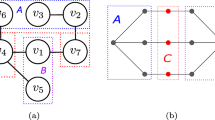Abstract
Causal discovery is a fundamental problem in scientific research. Although many researchers are committed to finding causal relationships from observational data, large-scale causal discovery remains a tremendous challenge. In this paper, a new approach for large-scale causal discovery is proposed, based on a split-and-merge strategy. The method first splits a given dataset into small subdatasets using a graph-partitioning method and then develops a effective algorithm to infer the causality of each subdataset. The entire causal structure with respect to the given dataset is achieved by combining all the causalities of each subdataset. The experimental results show that the proposed approach is effective and scalable for large-scale causal discovery problems.










Similar content being viewed by others
References
Cai R, Zhang Z, Hao Z (2013) Sada: a general framework to support robust causation discovery. In: Proceedings of the 30th international conference on machine learning, pp 208–216
Chickering DM (2003) Optimal structure identification with greedy search. J Mach Learn Res 3:507–554
Daniusis P, Janzing D, Mooij J, Zscheischler J, Steudel B, Zhang K, Schölkopf B (2012) Inferring deterministic causal relations. arXiv preprint arXiv:1203.3475
Fortier N, Sheppard J, Strasser S (2014) Abductive inference in Bayesian networks using distributed overlapping swarm intelligence. Soft Comput 19(4):981–1001
Geiger D, Heckerman D (1994) Learning gaussian networks. In: Proceedings of the tenth international conference on uncertainty in artificial intelligence. Morgan Kaufmann Publishers Inc, pp 235–243
Gullberg M, Noreus K, Brattsand G, Friedrich B, Shingler V (1990) Purification and characterization of a 19-kilodalton intracellular protein. An activation-regulated putative protein kinase c substrate of t lymphocytes. J Biol Chem 265(29):17499–17505
Gu B, Sheng VS (2016) A robust regularization path algorithm for v-support vector classification. IEEE Trans Neural Netw Learn Syst. doi:10.1109/TNNLS.2016.2527796
Gu B, Sun X, Sheng VS (2016) Structural minimax probability machine. IEEE Trans Neural Netw Learn Syst. doi:10.1109/TNNLS.2016.2544779
Hadley SW, Pelizzari C, Chen GTY (1996) Registration of localization images by maximization of mutual information. In: Proceedings of annual meeting of the American association of physicists in medicine
Hao Z, Zhang H, Cai R, Wen W, Li Z (2015) Causal discovery on high dimensional data. Appl Intell 42(3):594–607
Heckerman D, Meek C, Cooper G (1999) A bayesian approach to causal discovery. Comput Causation Discov 19:141–166
Herskovits E (1991) Computer-based probabilistic-network construction. Ph.D thesis, Stanford University, USA
Hoyer PO, Janzing D, Mooij JM, Peters J, Schölkopf B (2009) Nonlinear causal discovery with additive noise models. In: Advances in neural information processing systems. MIT press, Massachusetts, pp 689–696
Janzing D, Mooij J, Zhang K, Lemeire J, Zscheischler J, Daniušis P, Steudel B, Schölkopf B (2012) Information-geometric approach to inferring causal directions. Artif Intell 182:1–31
Kelly L, Clark J, Gilliland G (2002) Comprehensive genotypic analysis of leukemia: clinical and therapeutic implications. Curr Opin Oncol 14(1):10–18
Kim K-J, Cho S-B (2015) Ensemble bayesian networks evolved with speciation for high-performance prediction in data mining. Soft Comput. doi:10.1007/s00500-015-1841-z
Kraskov A, Stögbauer H, Grassberger P (2004) Estimating mutual information. Phys Rev E 69(6):066138
Kwak N, Choi C-H (2002) Input feature selection by mutual information based on parzen window. Pattern Anal Mach Intell IEEE Trans 24(12):1667–1671
Liu Z, Yan H, Li Z (2015a) Server-aided anonymous attribute-based authentication in cloud computing. Future Gener Comput Syst 24:61–66
Liu Z, Yan H, Lin Z, Xu L (2015b) An improved cloud data sharing scheme with hierarchical attribute structure. J Univers Comput Sci 21(3):454–472
Ma S, Li J, Liu L, Le TD (2016) Mining combined causes in large data sets. Knowl Based Syst 92:104–111
Meek C (1997) Graphical models: selecting causal and statistical models. Ph.D thesis, Carnegie Mellon University
Pearl J (2009) Causality. Cambridge University Press, Cambridge
Peters J, Janzing D, Schölkopf B (2010) Identifying cause and effect on discrete data using additive noise models. In: International conference on artificial intelligence and statistics, pp 597–604
Peters J, Janzing D, Schölkopf B (2011) Causal inference on discrete data using additive noise models. Pattern Anal Mach Intell IEEE Trans 33(12):2436–2450
Peters J, Mooij JM, Janzing D, Schölkopf B (2014) Causal discovery with continuous additive noise models. J Mach Learn Res 15(1):2009–2053
Rasmussen CE, Williams C (2006) Gaussian processes for machine learning. MIT Press, Cambridge
Schwarz G et al (1978) Estimating the dimension of a model. Ann Stat 6(2):461–464
Shimizu S, Hoyer PO, Hyvärinen A, Kerminen A (2006) A linear non-gaussian acyclic model for causal discovery. J Mach Learn Res 7:2003–2030
Spirtes P, Glymour CN, Richard S (2000) Causation, prediction and search, vol 81. MIT press, Cambridge
Tang L-J, Jiang J-H, Wu H-L, Shen G-L, Yu R-Q (2009) Variable selection using probability density function similarity for support vector machine classification of high-dimensional microarray data. Talanta 79(2):260–267
Wang X, Gotoh O (2009) Accurate molecular classification of cancer using simple rules. BMC Med Genom 2(1):64
Wen X, Shao L, Xue Y, Fang W (2015) A rapid learning algorithm for vehicle classification. Inf Sci 295:395–406
Zhang K, Hyvärinen A (2008) Distinguishing causes from effects using nonlinear acyclic causal models. In: Journal of machine learning research, workshop and conference proceedings (NIPS 2008 causality workshop), vol 6, pp 157–164
Zhang K, Peters J, Janzing D, Schölkopf B (2012) Kernel-based conditional independence test and application in causal discovery. arXiv preprint arXiv:1202.3775
Acknowledgments
This paper has been supported by Science and Technology Planning Project of Guangdong Province, China (2015A030401101), (2015B090922014), and by National Natural Science Foundation of China(61572144).
Author information
Authors and Affiliations
Corresponding author
Ethics declarations
Conflict of interest
The authors declare that they have no conflict of interest.
Additional information
Communicated by V. Loia.
Rights and permissions
About this article
Cite this article
Hong, Y., Liu, Z. & Mai, G. An efficient algorithm for large-scale causal discovery. Soft Comput 21, 7381–7391 (2017). https://doi.org/10.1007/s00500-016-2281-0
Published:
Issue Date:
DOI: https://doi.org/10.1007/s00500-016-2281-0




